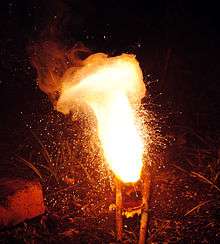Exothermic process
In thermodynamics, the term exothermic process (exo- : "outside") describes a process or reaction that releases energy from the system to its surroundings, usually in the form of heat, but also in a form of light (e.g. a spark, flame, or flash), electricity (e.g. a battery), or sound (e.g. explosion heard when burning hydrogen). Its etymology stems from the Greek prefix έξω (exō, which means "outwards") and the Greek word θερμικός (thermikόs, which means "thermal").[1] The term exothermic was first coined by Marcellin Berthelot. The opposite of an exothermic process is an endothermic process, one that absorbs energy usually in the form of heat.
The concept is frequently applied in the physical sciences to chemical reactions where chemical bond energy is converted to thermal energy (heat).
Exothermic (and endothermic) describe two types of chemical reactions or systems found in nature, as follows.
Simply stated, after an exothermic reaction, more energy has been released to the surroundings than was absorbed to initiate and maintain the reaction. An example would be the burning of a candle, wherein the sum of calories produced by combustion (found by looking at radiant heating of the surroundings and visible light produced, including the increase in temperature of the fuel (wax) itself, which oxygen converts to hot CO2 and water vapor) exceeds the number of calories absorbed initially in lighting the flame and in the flame maintaining itself (some energy is reabsorbed and used in melting, then vaporizing the wax, etc. but is far outstripped by the energy released in converting the relatively weak double bond of oxygen [2] to the stronger bonds in CO2 and H2O).
On the other hand, in an endothermic reaction or system, energy is taken from the surroundings in the course of the reaction, usually driven by a favorable entropy increase in the system. An example of an endothermic reaction is a first aid cold pack, in which the reaction of two chemicals, or dissolving of one in another, requires calories from the surroundings, and the reaction cools the pouch and surroundings by absorbing heat from them. The production of wood by photosynthesis is an endothermic process: trees absorb radiant energy from the sun and use it in endothermic reactions such as taking apart CO2 and H2O and recombining the atoms to produce cellulose and other organic chemicals, as well as O2. The wood may later be burned in a fireplace, exothermically releasing the energy of O2[2] in the form of heat and light to their surroundings, e.g. to a home's interior.
Overview
Exothermic refers to a transformation in which a closed system releases energy (heat) to the surroundings, expressed by
- Q < 0.
When the transformation occurs at constant pressure and without exchange of electrical energy, heat Q is equal to the enthalpy change, i.e.
- ∆H < 0,[3]
while at constant volume, according to the first law of thermodynamics it equals internal energy change, i.e.
- ∆U = Q + 0 < 0.
In an adiabatic system (i.e. a system that does not exchange heat with the surroundings), an otherwise exothermic process results in an increase in temperature of the system.[4]
In exothermic chemical reactions, the heat that is released by the reaction takes the form of electromagnetic energy or kinetic energy of molecules. The transition of electrons from one quantum energy level to another causes light to be released. This light is equivalent in energy to the stabilization energy of the energy for the chemical reaction, i.e. the bond energy. This light that is released can be absorbed by other molecules in solution to give rise to molecular translations and rotations, which gives rise to the classical understanding of heat. In an exothermic reaction, the energy needed to start the reaction is less than the energy that is subsequently released, so there is a net release of energy.
Examples

Some examples of exothermic processes are:[5]
- The reaction of alkali metals and other highly electropositive metals with water
- Condensation of rain from water vapor
- Mixing water and strong acids or strong bases
- The reaction of acids and bases
- Dehydration of carbohydrates by sulfuric acid
- The setting of cement and concrete
- Some polymerization reactions such as the setting of epoxy resin
- The reaction of most metals with halogens or oxygen
- Nuclear fusion in hydrogen bombs and in stellar cores (to iron)
- Nuclear fission of heavy elements
- The reaction between zinc and hydrochloric acid
- Respiration (breaking down of glucose to release energy in cells)
Implications for chemical reactions
Chemical exothermic reactions are generally more spontaneous than their counterparts, endothermic reactions.
In a thermochemical reaction that is exothermic, the heat may be listed among the products of the reaction.
Contrast between thermodynamic and biological terminology
Because of historical accident, students encounter a source of possible confusion between the terminology of physics and biology. Whereas the thermodynamic terms "exothermic" and "endothermic" respectively refer to processes that give out heat energy and processes that absorb heat energy, in biology the sense is effectively inverted. The metabolic terms "ectothermic" and "endothermic" respectively refer to organisms that rely largely on external heat to achieve a full working temperature, and to organisms that produce heat from within as a major factor in controlling their bodily temperature.
See also
References
- "Gate for the Greek language" on-line dictionary Archived 2017-12-05 at the Wayback Machine. greek-language.gr
- Schmidt-Rohr, K. (2015). "Why Combustions Are Always Exothermic, Yielding About 418 kJ per Mole of O2", J. Chem. Educ. 92: 2094-2099. http://dx.doi.org/10.1021/acs.jchemed.5b00333
- Oxtoby, D. W; Gillis, H.P., Butler, L. J. (2015).Principles of Modern Chemistry, Brooks Cole. p. 617. ISBN 978-1305079113
- Perrot, Pierre (1998). A to Z of Thermodynamics. Oxford University Press. ISBN 0-19-856552-6.
- Exothermic – Endothermic examples Archived 2006-09-01 at the Wayback Machine. frostburg.edu
External links
| Look up exothermic in Wiktionary, the free dictionary. |
- http://chemistry.about.com/b/a/184556.htm Observe exothermic reactions in a simple experiment